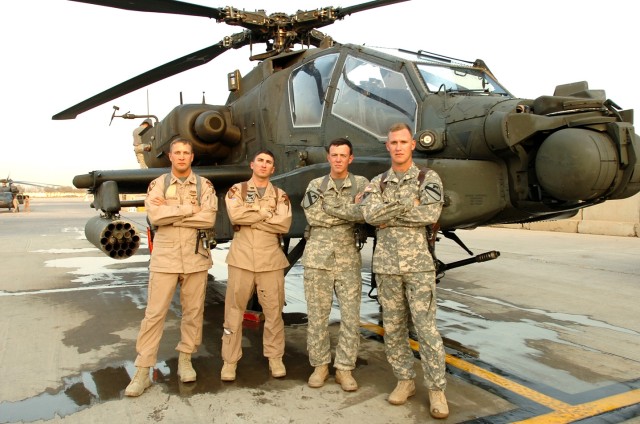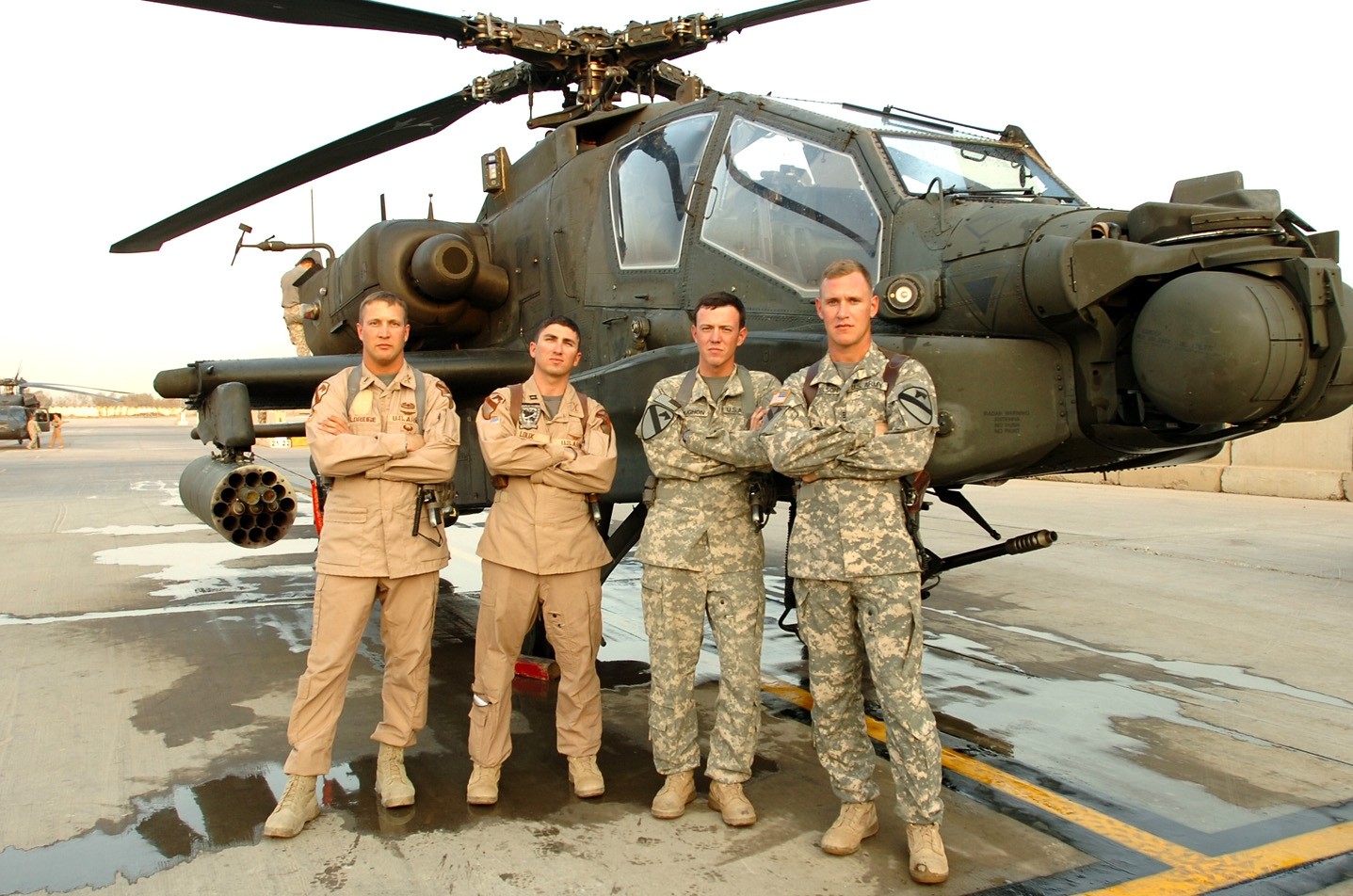
CAMP TAJI, Iraq - For the past year, Apache pilots from the 1st Air Cavalry Brigade have conducted countless reconnaissance missions in search of roadside bombs and mortar systems aimed toward forward operating bases or Iraqi neighborhoods.
Four pilots from 1st "Attack" Battalion, 227th Aviation Regiment, 1st ACB, 1st Cavalry Division, were flying just such a mission when they happened upon up to 20 insurgents armed with rifles and rocket-propelled grenade launchers and manning four anti-aircraft gun trucks Sept. 29.
Three short seconds after the pilots spotted the gun trucks, they were under fire.
"From the time that I first saw them first and could get (a visual) on them was probably three seconds until we were passing by. It was a pretty quick amount of time until we got into the actual getting engaged," said Chief Warrant Officer 3 Terry Eldridge, pilot in command for the lead aircraft, who calls Killeen, Texas, home. "As soon as we passed, I kind of veered off to one side, and they started tracking us with the guns from the back of the trucks. As soon as they got where we were inside their range, effectively for their shots, they started shooting - so, about the time it takes to swing a turret, in this case a gun on a tripod mount."
"It was pretty much instantaneous," added Capt. Thomas Loux, air mission commander for the mission. "We saw them as they opened fire."
Eldridge said that, in that short amount of time, he thought less about himself and his aircraft than of his wingman aircraft, which was about to fly into the same situation. He radioed Chief Warrant Officer 3 Kyle Kittleson, pilot in command of the trail aircraft.
"I came on the radio talking to (Kittleson) ... to try to get him focused on where he was at, because he was coming along behind me. As quickly as possible, I tried to get the helicopter oriented back on the area where we were taking fire from and try to get some suppressive fire out to decrease the amount of effective fires they had on us."
Meanwhile, Loux was talking on another radio to the ground unit from 2nd Battalion, 8th Cavalry Regiment, 1st Brigade Combat Team, 1st Cav. Div. to alert them of the situation and see if any back-up aircraft were in the area.
"We had ... a sister team from another company working pretty much the same area south of us," said Loux, a native of Fort Myers, Fla. "I heard them checking out on the ground net. When I heard them, I called them to get them in the area. We weren't too sure on how this was going to go. We saw multiple machine guns, and they pretty much had a bead on us."
Eldridge and Loux had already taken fire and were turning back in to engage the insurgents before Kittleson and Chief Warrant Officer 2 Cole Moughon flew into the area.
"As soon as he starts taking fire ... and basically (returned) back to target, we were coming inbound," said Kittleson, a Copperas Cove, Texas, native. "We suppressed one of the gun trucks with 30 millimeter (rounds) and rockets. On the second pass, Cole took a round in the canopy above his head. We coordinated our turns inbound-outbound between the two aircraft."
Seemingly surprised by the Apache pilots' quick reaction, the insurgents scattered.
"They were initially gathered there in the road," Kittleson said. "As soon as Terry put his suppressive fire rockets down, they started dispersing. (They) had a guy in one of the gun trucks still firing, but, as we came around and suppressed with 30 (millimeter) and more rockets, they all pretty much scattered into the building like little cockroaches."
Although they fled the open area at the four-way intersection, the insurgents continued to fire on the two Apaches once they found cover in nearby buildings.
"Pretty much every person out there hade a weapon of varying degrees," Eldridge said. "For the first seven to ten minutes, somebody was shooting at us the whole time. We established a pretty on-the-fly dynamic plan. We put together the best attack angles that we could at the time to keep each other covered. That was ... the primary intent - to keep their heads down, get effective fires on the enemy and keep each other protected."
The four continued to engage the insurgents while the sister Apache team that had arrived a few minutes into the fight remained at a higher altitude to prevent having too many aircraft in the area.
"We were trying to get them into the fight, but, from what they said, we were kind of all over the place looking like angry bees," Loux said. "They didn't want to get into the area and cause a mid-air (collision) while we were trying to engage the enemy."
By the time the Apache team was out of ammo, up to 15 of the insurgents were dead and the gun trucks were disabled. They handed off the targets to their sister Apache team to further engage the vehicles and destroy them, Loux said.
The entire engagement lasted less than 15 minutes, although it seemed longer, Loux said.
"Perceived, it seemed like forever," Loux said. "I thought it was at least a half hour, but when we looked at the tape, it was only half that."
Even several days after the engagement, when the pilots participated in a battalion after-action review, Moughon said he could remember the flashes of the insurgents' weapons.
"You see that flash, and it scares you, especially when you start taking rounds off the cockpit," said Moughon, a native of Gray, Ga. "Then, you think about your buddies - the guy flying with you and the two guys that are flying with you in the other aircraft. You think: 'We've got to take care of this.'"
The crews credit their success in the engagement to communication with each other and the ground unit and their experience as a team.
"This particular team has been operating together for a couple of months now," Loux said. "It definitely helps that we're real familiar with how each other works. Everything kind of kicked in at once. We all started doing what we needed to do, because we knew what the other person was going to do. It wasn't something that we had to always consciously talk about."
But the intensity of the fight and the numbers of armed insurgents gathered in one place added up to more than these crews had seen during their 12 months in Iraq on this deployment.
"This is my third rotation over here," Eldridge said. "I had seen other firefights when were down in Sadr City ... during OIF II. I will say this is probably one of the more intense firefights that we've seen this rotation. We personally have not seen a whole lot of consolidated fire of that magnitude."
Although the crews' quick reactions were integral in their survival, they said they can't take all of the credit.
"(We) would not have been at the right place at the right time - or wrong time, whichever way you look at it - had it not been for our crew chiefs being on the ball. From the guys that we talked to that morning to the crew chiefs, it was a team effort and turned out in our favor."

Social Sharing